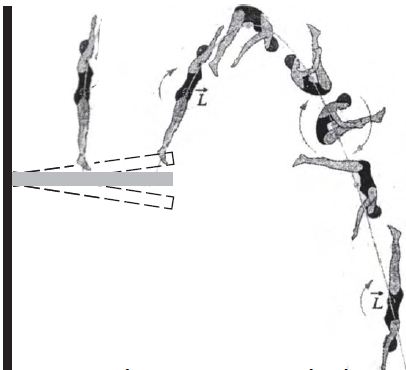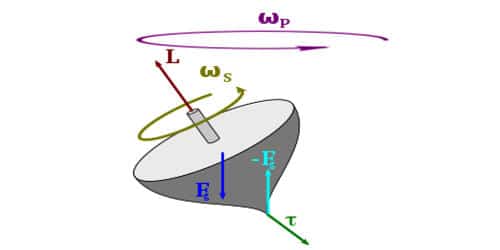The law of conservation of angular momentum states that when no external torque acts on an object, no change of angular momentum will occur. Angular momentum depends on the rotational velocity of an object, but also its rotational inertia. When an object changes its shape (rotational inertia), its angular velocity will also change if there is no external torque. Conservation of angular momentum is generally believed to be the counterpart of conservation of linear momentum as studied in the case of translation.
From the law of conservation of angular momentum, I ω = constant
ω ∞ 1/T, the angular velocity of rotation is inversely proportional to the moment of inertia of the system.
Following are the examples for the law of conservation of angular momentum:
(1) A diver jumping from springboard sometimes exhibits somersaults in the air before reaching the water surface, because the diver curls his body to decrease the moment of inertia and increase angular velocity.

Fig: A diver jumping from a springboard
The springboard jumper follows a parabolic path of a projectile. In this case, the motion is about an accelerated axis of rotation, which moves along the parabolic path. In the beginning, the jumper keeps hands and legs stretched. During the flight, he/she curls the body to decrease the moment of inertia. This results in increased angular velocity i.e. more turns before the jumper hits the water. When he is about to reach the water surface, he again outstretches his limbs This again increases the moment of inertia and decreases the angular velocity. Hence, the diver enters the water surface with a gentle speed.
(2) A ballet dancer can increase her angular velocity by folding her arms, as this decreases the moment of inertia.

Fig: A person rotating on a turntable
(3) Fig. a, shows a person sitting on a turntable holding a pair of heavy dumbbells one in each hand with arms outstretched. The table is rotating with a certain angular velocity. The person suddenly pushes the weight towards his chest as shown in Fig. b, the speed of rotation is found to increase considerably.
(4) The angular velocity of a planet in its orbit around the sun increases when it is nearer to the Sun, as the moment of inertia of the planet about the Sun decreases.
(5) An ice skater rotates with outstretched hands on one leg. When he/she folds the hands and two legs closer to the axis of rotation, the moment of inertia of the body decreases. As a consequence, ice skater begins to spin at much greater angular velocity.









